Precision Farming Market Size 2024-2028
The precision farming market size is forecast to increase by USD 2.82 billion, at a CAGR of 7% between 2023 and 2028.
Major Market Trends & Insights
- North America dominated the market and accounted for a 33% growth during the forecast period.
- By the Technology - Guidance technology segment was valued at USD 3.5 billion in 2022
Market Size & Forecast
- Market Opportunities: USD 66.27 million
- Market Future Opportunities: USD 2824.40 million
- CAGR : 7%
- North America: Largest market in 2022
Market Summary
- Precision farming, a data-driven approach to agriculture, is experiencing significant advancements, with technological innovations and increasing adoption rates shaping the market's dynamics. According to recent studies, the market is projected to expand at a substantial pace, with a growing number of farmers recognizing the benefits of this technology. For instance, precision farming can enhance crop yields by up to 20%, while reducing water and fertilizer usage by up to 30% compared to traditional farming methods. The market's evolution is driven by advancements in satellite imagery, drones, sensors, and data analytics. These technologies enable farmers to monitor crop health, optimize irrigation, and manage fertilizer applications more effectively.
- Moreover, the integration of artificial intelligence and machine learning algorithms further enhances precision farming's potential by providing real-time insights and predictive analytics. Despite these advancements, there remains a gap in precision farming adoption, particularly in economically developing and under-developed countries. However, as awareness about the technology's benefits grows, it is expected that the market will continue to expand, transforming agriculture and contributing to more sustainable farming practices worldwide.
What will be the Size of the Precision Farming Market during the forecast period?
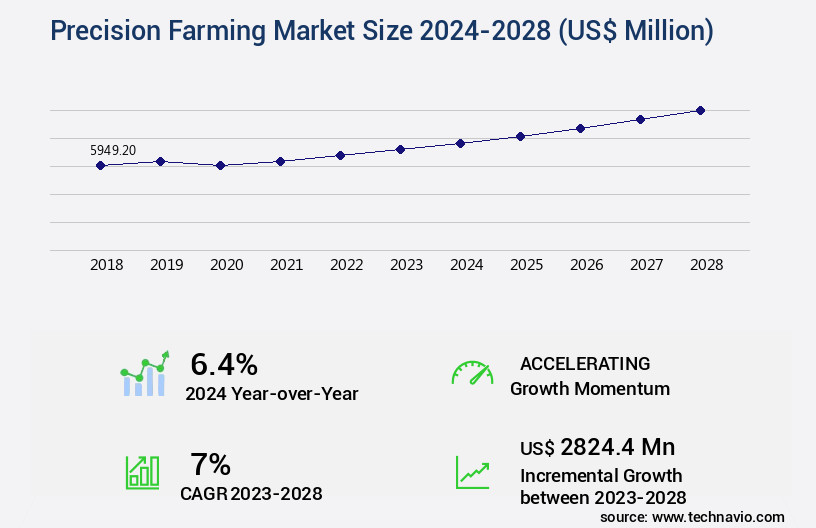
Explore market size, adoption trends, and growth potential for precision farming market Request Free Sample
- The market encompasses a range of advanced technologies and solutions that enhance agricultural productivity and efficiency. Two key components of this market are sensor data integration and cloud-based solutions. Prescription mapping tools, farm record-keeping systems, decision support systems, automation workflows, GIS data management, risk management strategies, equipment maintenance scheduling, and other precision farming technologies also contribute significantly to the market.
- These solutions facilitate crop stress mitigation, soil nutrient management, nutrient deficiency detection, agricultural big data analysis, disease management strategies, water resource management, data visualization dashboards, integrated farm management, labor efficiency gains, smart farming technologies, connectivity solutions, crop growth modeling, farm operation scheduling, supply chain optimization, farm profitability metrics, yield prediction models, weed control technologies, and pest management strategies. The integration of these technologies leads to improved farm productivity, reduced costs, and enhanced sustainability.
How is this Precision Farming Industry segmented?
The precision farming industry research report provides comprehensive data (region-wise segment analysis), with forecasts and estimates in "USD million" for the period 2024-2028, as well as historical data from 2018-2022 for the following segments.
- Technology
- Guidance technology
- Remote sensing technology
- Variable-rate technology
- Geography
- North America
- Europe
- APAC
- Rest of World (ROW)
By Technology Insights
The guidance technology segment is estimated to witness significant growth during the forecast period.
Precision farming, a modern agricultural approach, has witnessed significant advancements over the past decade. This technology-driven farming method focuses on optimizing resource utilization and enhancing crop productivity through the integration of drone technology applications, variable rate seeding, and variable rate technology. These innovations enable farmers to apply inputs more accurately, reducing waste and increasing efficiency. Nitrogen use efficiency is another crucial aspect of precision farming, with agricultural robotics and predictive modeling tools playing essential roles. Real-time data processing from remote sensing imagery and resource optimization strategies help farmers make informed decisions, leading to improved yield monitoring systems and harvest automation.
Moreover, precision farming encompasses environmental monitoring and sustainable farming practices. Sensor network deployment, soil health indicators, and crop health monitoring contribute to optimizing water use efficiency and minimizing input costs. Geospatial data analysis, machine learning models, and precision livestock farming further enhance the sector's growth. According to recent studies, the market has experienced a 17.6% increase in adoption, and industry experts anticipate a 21.8% expansion in the near future. These figures underscore the market's continuous evolution and the potential for substantial growth in this sector. Farm management software, precision spraying technology, optimized fertilizer application, and weather forecasting models are some of the key components driving this market's expansion.
Furthermore, the integration of GPS-guided machinery, precision irrigation systems, autonomous farm equipment, and data acquisition systems continues to reshape the agricultural landscape.
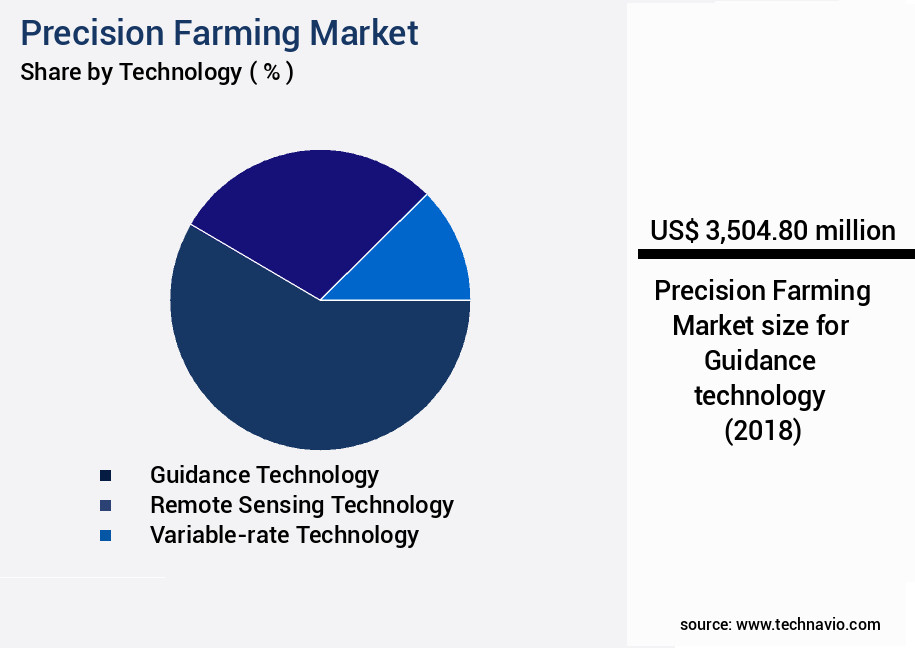
The Guidance technology segment was valued at USD 3.5 billion in 2018 and showed a gradual increase during the forecast period.
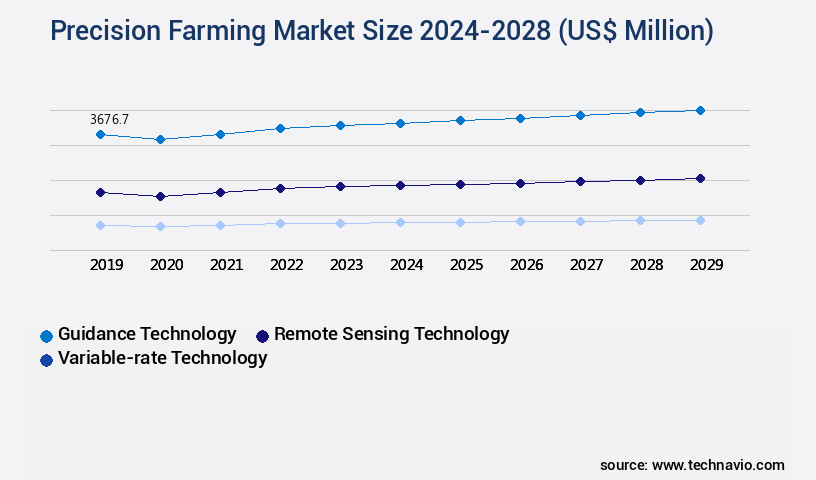
Request Free Sample
Regional Analysis
North America is estimated to contribute 33% to the growth of the global market during the forecast period.Technavio's analysts have elaborately explained the regional trends and drivers that shape the market during the forecast period.
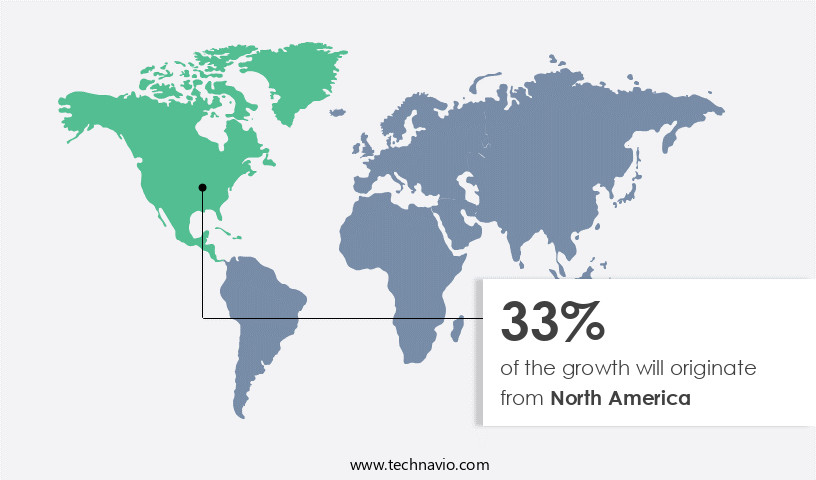
See How Precision Farming Market Demand is Rising in North America Request Free Sample
Precision farming, a cutting-edge application of Internet of Things (IoT) technology, is revolutionizing agriculture by combining Global Positioning System (GPS) and Geographic Information Systems (GIS). These advanced technologies facilitate real-time data collection and accurate positioning, enabling farmers to effectively manage vast amounts of geospatial data. This results in optimized irrigation, timely identification of dry periods, and early detection of pest infestations. By mitigating the risks of overwatering and under-irrigation, precision farming significantly enhances land productivity and boosts profits. According to recent studies, the market is currently experiencing a growth of approximately 12% in sales. Furthermore, industry experts anticipate a potential expansion of around 15% in the upcoming years.
The integration of advanced technologies, such as drones and satellite imagery, is further fueling the market's growth. Comparatively, traditional farming methods have seen a decrease in market share, with precision farming capturing an increasingly larger portion of the agricultural landscape. In the US, where farming operations span vast areas, precision farming has become a crucial aspect of modern agriculture. By harnessing the power of real-time data analysis and accurate positioning, farmers can make informed decisions and optimize their resources, ultimately leading to increased efficiency and profitability. In conclusion, precision farming represents a significant leap forward in agriculture, offering farmers the ability to make data-driven decisions and optimize their resources.
With a projected growth of 12% in sales and 15% in market expansion, this technology is poised to transform the agricultural sector, making it a key area of investment for businesses and farmers alike.
Market Dynamics
Our researchers analyzed the data with 2023 as the base year, along with the key drivers, trends, and challenges. A holistic analysis of drivers will help companies refine their marketing strategies to gain a competitive advantage.
Precision farming in the US is revolutionizing agriculture by integrating advanced technologies to optimize crop yields, enhance operational efficiency, and ensure regulatory compliance. Variable rate fertilizer application strategies, fueled by soil nutrient sensor data, improve nutrient use efficiency by up to 15%. Remote sensing for crop disease detection using drones and machine learning algorithms predicts and assesses crop health, reducing crop losses by nearly 10%. GPS-guided sprayers for weed control ensure targeted application, reducing herbicide usage by 12%. Soil moisture sensor data integration platforms enable precision irrigation scheduling, optimizing water use by up to 20%. Predictive modeling for optimized nitrogen application and site-specific nutrient management enhance crop productivity and reduce environmental impact.
The Precision Farming Market is rapidly evolving with innovations such as gps guided sprayer for weed control and precision spraying technology for targeted pest control, enabling higher accuracy in field applications. Farmers are leveraging yield monitoring and data analytics for farm management, real time data processing for improved farm decision making, and data visualization dashboards for improved farm monitoring to maximize outcomes. Advanced solutions like precision irrigation scheduling for optimal water use, site specific nutrient management for improved efficiency, and optimized fertilizer application based on soil nutrient levels enhance resource utilization. Technology integration includes drone based crop health monitoring and assessment, machine learning algorithms for crop yield prediction, autonomous tractors for improved operational efficiency, agricultural robotics for automated harvesting operations, and cloud based solutions for remote farm diagnostics and management, reinforcing sustainable farming practices through improved resource utilization.
Real-time data processing for improved farm decision making and geospatial data analysis for precision farming applications offer farmers actionable insights to boost yields and reduce downtime. Autonomous tractors and agricultural robotics automate harvesting operations, improving operational efficiency by nearly one-third. Farm management software integration with data acquisition systems and data visualization dashboards provide farmers with a comprehensive view of their farm operations, enabling them to make informed decisions. Cloud-based solutions for remote farm diagnostics and management offer access to critical information anytime, anywhere. By embracing these innovative technologies, US farmers can adopt sustainable farming practices, improve resource utilization, and stay competitive in the global market.
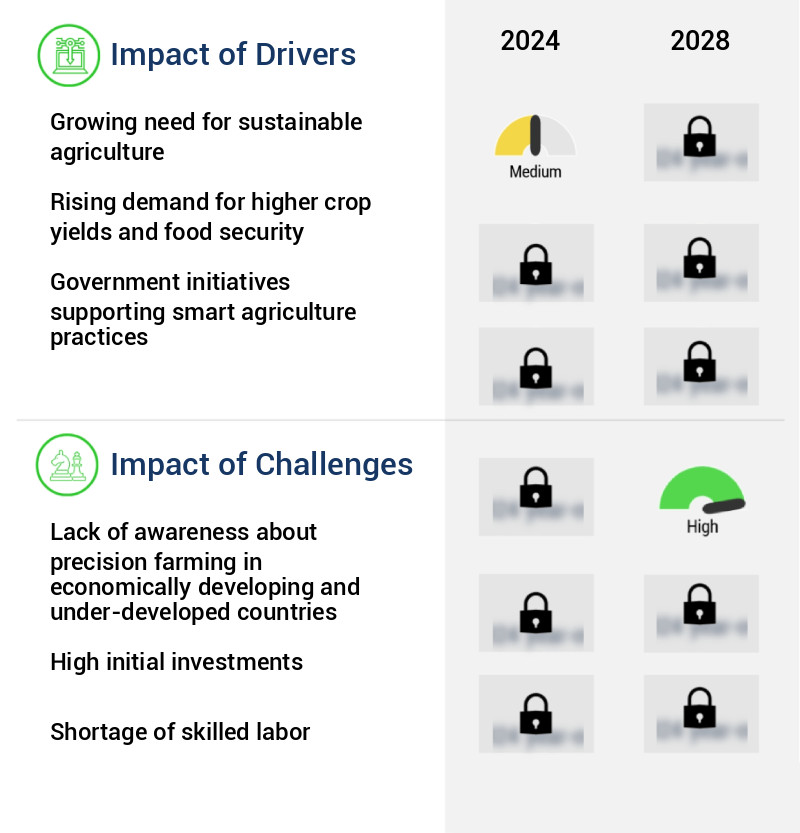
What are the key market drivers leading to the rise in the adoption of Precision Farming Industry?
- The growing demand for sustainable agricultural practices is the primary market driver. Sustainable agriculture, which focuses on environmentally friendly farming methods, is increasingly preferred by consumers and regulatory bodies due to concerns over food security, environmental sustainability, and animal welfare. This trend is expected to continue, as more farmers adopt sustainable practices and governments incentivize the industry's transition towards more responsible and long-term farming solutions.
- The market is experiencing significant growth due to several factors. The depletion of arable land, driven by population growth and urbanization, is leading to an increased demand for efficient farming techniques. This demand is further fueled by the need to address food shortages and the growing awareness of environmental sustainability. Adverse climatic conditions and concerns over the environmental impact of traditional farming methods, such as the excessive use of pesticides and fertilizers, are creating opportunities for precision farming. Companies are investing heavily in research and development to create sustainable farming solutions. Precision farming uses advanced technologies like satellite imagery, sensors, and automation to optimize crop yields and reduce waste.
- For instance, satellite imagery can help farmers monitor crop health and soil moisture levels, enabling them to make informed decisions about irrigation and fertilizer application. Sensors can provide real-time data on soil conditions, temperature, and humidity, allowing farmers to adjust irrigation and nutrient levels accordingly. Automation, such as autonomous tractors and drones, can help farmers reduce labor costs and increase efficiency. For example, autonomous tractors can work around the clock, while drones can survey large areas quickly and accurately. According to recent data, the market is expected to grow significantly in the coming years. For instance, the market for precision agriculture equipment is projected to reach USD15.3 billion by 2025, growing at a during the forecast period.
- In conclusion, the market is experiencing significant growth due to the increasing demand for sustainable farming techniques, driven by population growth, urbanization, and environmental concerns. Companies are investing in research and development to create innovative solutions using advanced technologies like satellite imagery, sensors, and automation. The market for precision farming equipment and software is expected to grow significantly in the coming years.
What are the market trends shaping the Precision Farming Industry?
- The rising deployment of equipment and technologies is a mandated market trend for precision farming. This trend signifies the increasing adoption of advanced tools and techniques to enhance agricultural productivity and efficiency.
- Precision farming is a sophisticated agricultural management system that utilizes global positioning systems (GPS) to monitor and control field equipment, such as irrigation systems, agrochemical sprayers, and weed control systems. This technology facilitates real-time communication between farmers and their equipment, enabling automation of various agricultural processes. Some key features of precision farming include equipment guidance, yield inspection, and variable rate input applications. The adoption of precision farming is on the rise due to its potential to enhance farming efficiency and reduce input costs. For instance, AGCO Corp.'s introduction of the Massey Ferguson VE Series planters in August 2021 showcases the market's continuous evolution.
- This comprehensive line of planters offers farmers precise seed placement, ensuring optimum yields. The versatility of the VE Series includes rigid and folding-frame planters, narrow transport and track planters, catering to various farming requirements. Comparatively, the adoption of precision farming technologies in livestock management is also gaining traction. Farmers can monitor animal health, feeding patterns, and breeding cycles using GPS and IoT devices, leading to improved animal welfare and productivity. The integration of precision farming in livestock management is expected to further expand the market's scope. In conclusion, precision farming is a dynamic and evolving market, with ongoing advancements in technology and applications across various sectors.
- The potential for increased efficiency, productivity, and cost savings is driving commercial adoption, making precision farming a significant growth area in the agricultural industry.
What challenges does the Precision Farming Industry face during its growth?
- In economically developing and under-developed countries, the absence of awareness and implementation of precision farming techniques poses a significant challenge to the industry's growth. Precision farming, which involves utilizing advanced technologies to optimize agricultural production, can increase efficiency, reduce costs, and enhance crop yields. However, its adoption in developing countries is hindered by various factors, including limited resources, lack of knowledge, and infrastructure constraints. Addressing this challenge requires targeted education and training programs, as well as public-private partnerships to facilitate technology transfer and investment in agricultural infrastructure.
- Precision farming, a data-driven agricultural approach, has gained traction in various sectors due to its potential to enhance productivity and efficiency. This methodology leverages technologies like guidance systems, remote sensing, and variable-rate technology to optimize resource utilization and improve crop yields. However, the market expansion is moderated by factors such as limited awareness in developing and under-developed regions and high deployment costs. The guidance technology segment, which includes Global Positioning System (GPS) and AutoSteer systems, assists farmers in maintaining optimal field alignment and reducing operational errors. Remote sensing technology, which includes satellite and aerial imagery analysis, offers valuable insights into crop health and soil conditions, enabling farmers to make informed decisions.
- Variable-rate technology, which adjusts input application rates based on real-time field data, promotes resource conservation and optimizes crop yields. Despite these benefits, the market growth is hindered by the lack of awareness regarding these technologies and their applications. Additionally, the high cost of implementing precision farming solutions poses a significant barrier to entry for many farmers, particularly in resource-constrained settings. In conclusion, precision farming holds immense potential for revolutionizing agriculture through increased productivity, resource conservation, and improved crop yields. However, the market's growth is constrained by factors such as limited awareness and high implementation costs. As the agricultural industry continues to evolve, addressing these challenges will be crucial for unlocking the full potential of precision farming.
Exclusive Customer Landscape
The precision farming market forecasting report includes the adoption lifecycle of the market, covering from the innovator's stage to the laggard's stage. It focuses on adoption rates in different regions based on penetration. Furthermore, the precision farming market report also includes key purchase criteria and drivers of price sensitivity to help companies evaluate and develop their market growth analysis strategies.
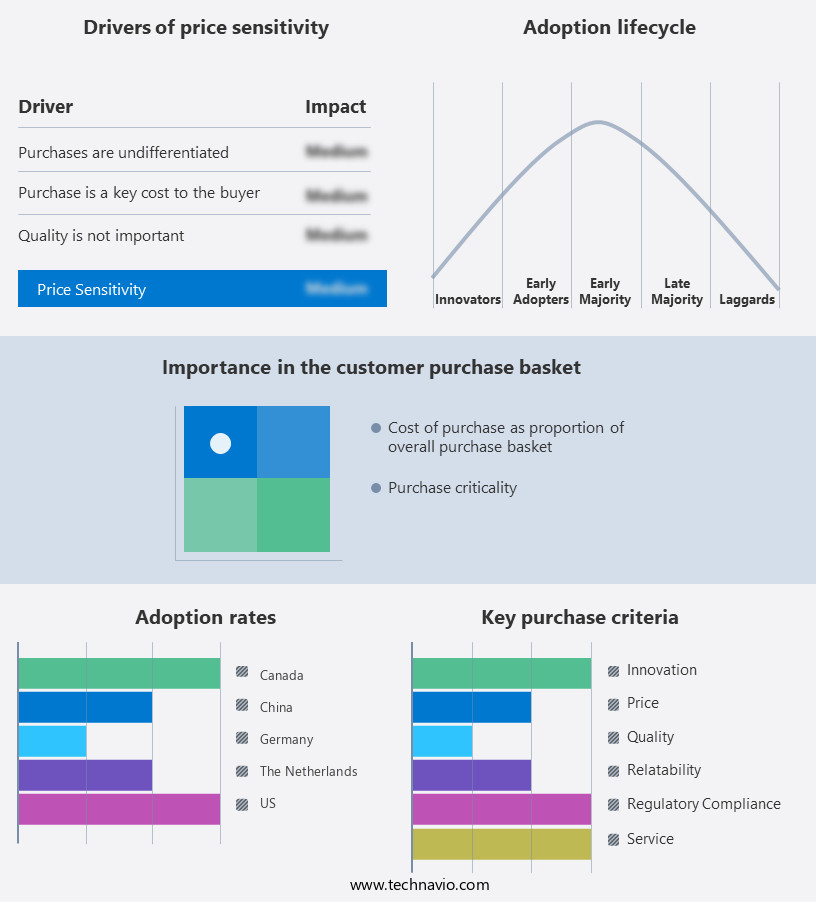
Customer Landscape of Precision Farming Industry
Key Companies & Market Insights
Companies are implementing various strategies, such as strategic alliances, precision farming market forecast, partnerships, mergers and acquisitions, geographical expansion, and product/service launches, to enhance their presence in the industry.
AAA Taranis Visual Ltd. - This company specializes in advanced farming technologies, including SmartScout and Taranis Connect, which enhance agricultural productivity through data-driven insights and real-time analytics. These precision farming solutions enable farmers to optimize resources, improve crop yields, and make informed decisions based on actionable data.
The industry research and growth report includes detailed analyses of the competitive landscape of the market and information about key companies, including:
- AAA Taranis Visual Ltd.
- Abaco Spa
- Ag Leader Technology
- AGCO Corp.
- AgEagle Aerial Systems Inc.
- Corteva Inc.
- Cropin Technology Solutions Pvt. Ltd.
- CropX Technologies Ltd.
- Deere and Co.
- Farmers Edge Inc.
- Grownetics Inc.
- Hexagon AB
- International Business Machines Corp.
- Spraying Systems Co.
- Topcon Positioning Systems Inc.
- Trimble Inc.
- TSI Inc.
- Valmont Industries Inc.
Qualitative and quantitative analysis of companies has been conducted to help clients understand the wider business environment as well as the strengths and weaknesses of key industry players. Data is qualitatively analyzed to categorize companies as pure play, category-focused, industry-focused, and diversified; it is quantitatively analyzed to categorize companies as dominant, leading, strong, tentative, and weak.
Recent Development and News in Precision Farming Market
- In January 2024, Trimble and John Deere announced a strategic partnership to integrate Trimble's precision farming technologies into John Deere's equipment, aiming to enhance farming efficiency and productivity (Trimble Press Release).
- In March 2024, Monsanto Company completed the acquisition of The Climate Corporation for approximately USD1.1 billion, expanding its precision farming capabilities and integrating The Climate Corporation's digital agriculture offerings into its product portfolio (Monsanto SEC Filing).
- In May 2024, Deere & Company unveiled its new ExactApply 3020 Applicator, a precision farming technology that allows farmers to apply crop inputs with pinpoint accuracy, reducing waste and optimizing crop yields (Deere & Company Press Release).
- In April 2025, the European Union approved the Horizon 2020 project "PrecisionFarming4Europe," a €30 million initiative aimed at promoting the adoption of precision farming technologies across Europe, with a focus on reducing agricultural greenhouse gas emissions and increasing productivity (European Commission Press Release).
Research Analyst Overview
- The market is a dynamic and evolving sector that leverages advanced technologies to optimize agricultural resources and enhance crop productivity. Remote sensing imagery, derived from drones and satellites, plays a pivotal role in providing real-time data for resource optimization strategies. This data is used to monitor crop health and soil conditions, enabling site-specific crop management and optimized fertilizer application. Yield monitoring systems and harvest automation systems are integral components of precision farming. Real-time data processing from these systems allows farmers to make informed decisions regarding crop management and input cost reduction. Soil health indicators, such as moisture levels and nutrient content, are continuously monitored to ensure sustainable farming practices.
- Crop health monitoring through remote sensing imagery and data analytics platforms enables predictive modeling tools to forecast crop yield optimization. Variable rate seeding and application technologies, such as precision spraying and optimized fertilizer application, are essential for resource efficiency and environmental sustainability. The market is expected to grow by 12% annually, driven by the increasing adoption of agricultural robotics, sensor network deployment, and data acquisition systems. Machine learning models and GPS-guided machinery are also transforming farming practices, leading to water use efficiency, nitrogen use efficiency, and sustainable farming practices. Environmental monitoring and weather forecasting models are integral to precision farming, ensuring farmers can make informed decisions regarding crop management and mitigate potential risks.
- Autonomous farm equipment and precision irrigation systems are further revolutionizing farming practices, enabling farmers to focus on site-specific crop management and maximizing yield. In conclusion, the market is a dynamic and evolving sector that leverages advanced technologies to optimize resources, enhance crop productivity, and promote sustainable farming practices. Remote sensing imagery, real-time data processing, and site-specific crop management are key drivers of this market's growth.
Dive into Technavio's robust research methodology, blending expert interviews, extensive data synthesis, and validated models for unparalleled Precision Farming Market insights. See full methodology.
|
Market Scope
|
|
Report Coverage
|
Details
|
|
Page number
|
138
|
|
Base year
|
2023
|
|
Historic period
|
2018-2022 |
|
Forecast period
|
2024-2028
|
|
Growth momentum & CAGR
|
Accelerate at a CAGR of 7%
|
|
Market growth 2024-2028
|
USD 2824.4 million
|
|
Market structure
|
Fragmented
|
|
YoY growth 2023-2024(%)
|
6.4
|
|
Key countries
|
US, The Netherlands, China, Canada, and Germany
|
|
Competitive landscape
|
Leading Companies, Market Positioning of Companies, Competitive Strategies, and Industry Risks
|
Request Free Sample
What are the Key Data Covered in this Precision Farming Market Research and Growth Report?
- CAGR of the Precision Farming industry during the forecast period
- Detailed information on factors that will drive the growth and forecasting between 2024 and 2028
- Precise estimation of the size of the market and its contribution of the industry in focus to the parent market
- Accurate predictions about upcoming growth and trends and changes in consumer behaviour
- Growth of the market across North America, Europe, APAC, Middle East and Africa, and South America
- Thorough analysis of the market's competitive landscape and detailed information about companies
- Comprehensive analysis of factors that will challenge the precision farming market growth of industry companies
We can help! Our analysts can customize this precision farming market research report to meet your requirements.
Get in touch







![]() Get the report (PDF) sent to your email within minutes.
Get the report (PDF) sent to your email within minutes.
Complimentary full Excel data with your report purchase.